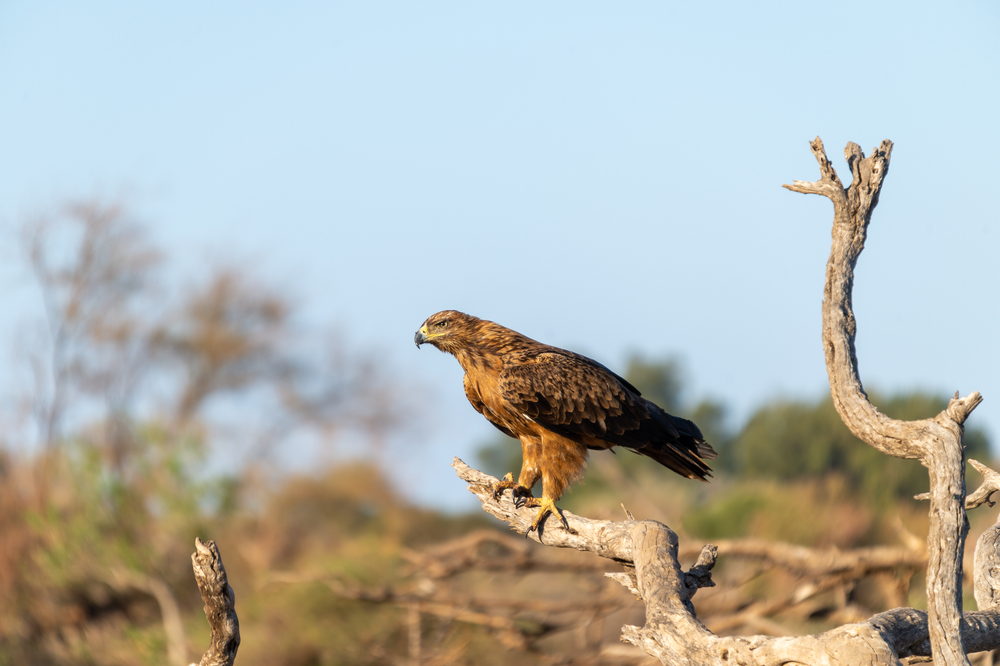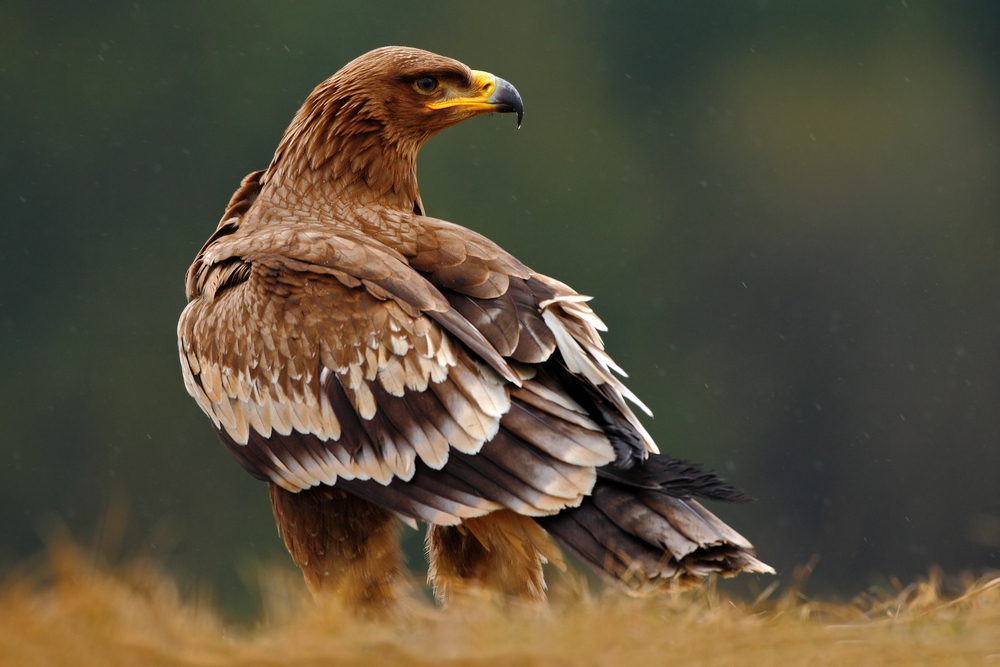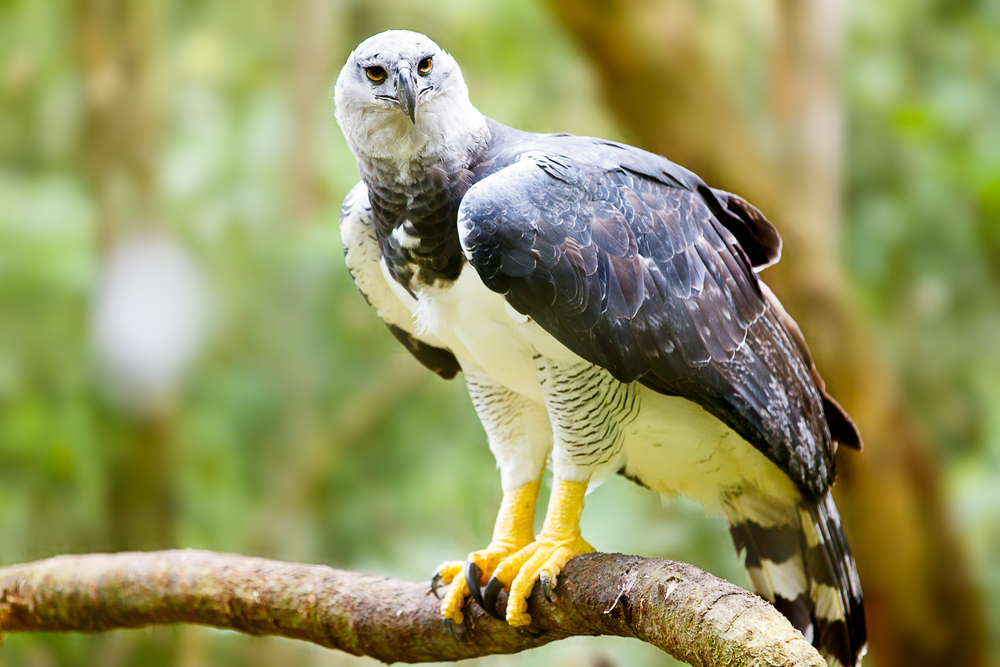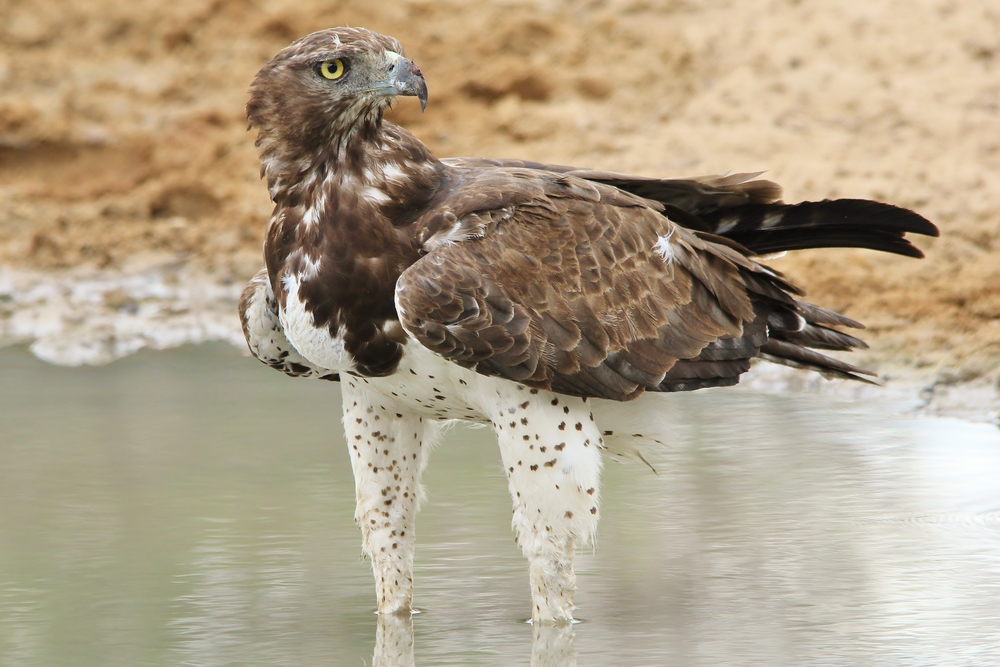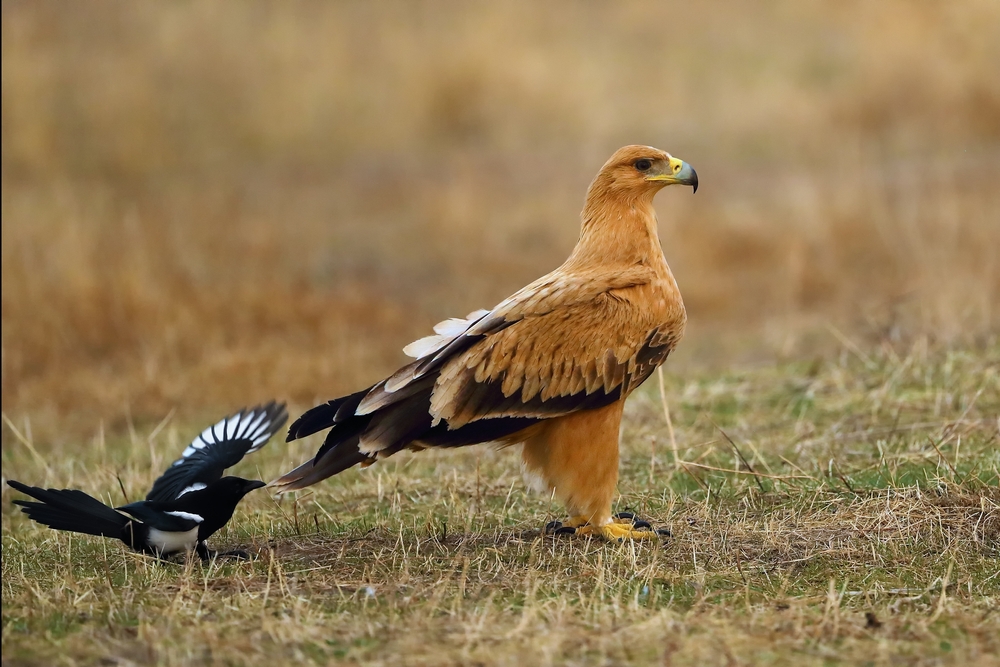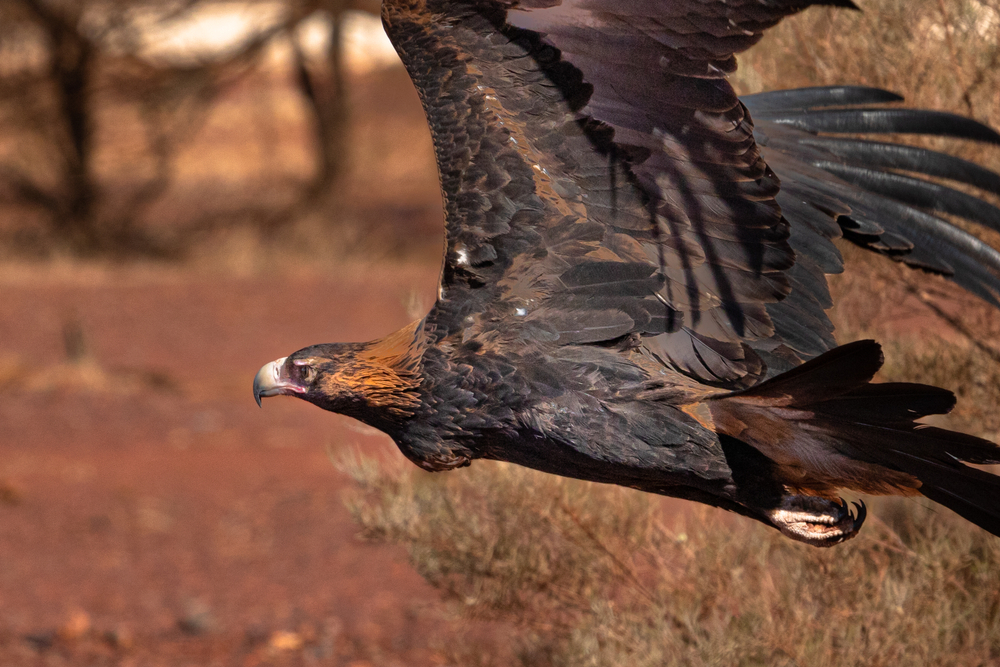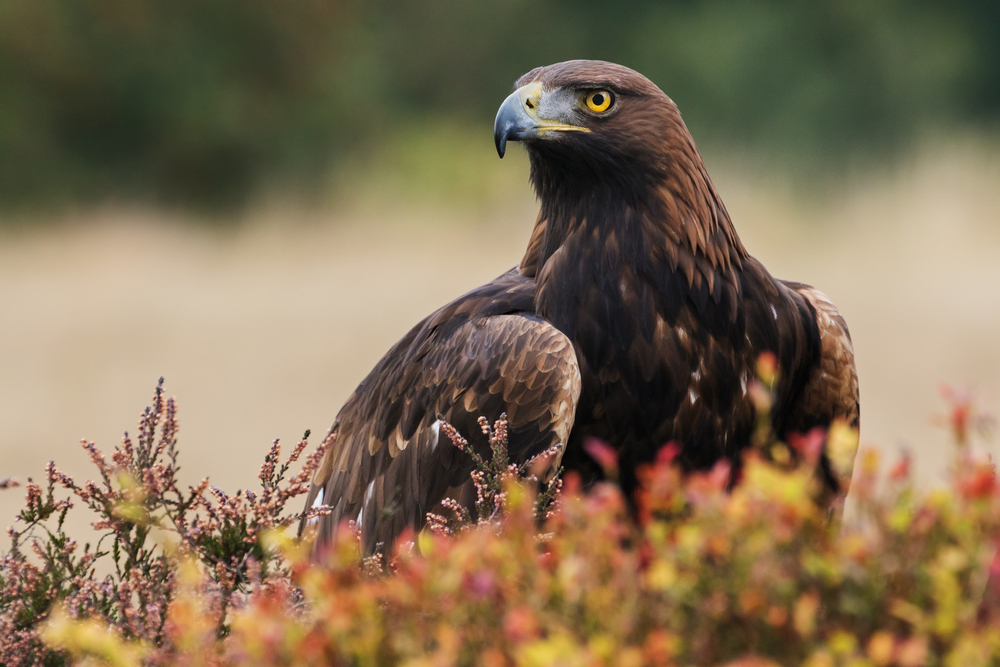The Tawny Eagle is most closely related to the Steppe Eagle (Aquila nipalensis). The two were once considered the same species, but genetic studies and behavioral differences now separate them.
About
The Tawny Eagle is a widespread raptor of Africa, the Middle East, and parts of South Asia, known for its versatility, resilience, and commanding presence across savannas, deserts, and open woodlands. Its plumage ranges from pale sandy-brown to darker tawny shades, providing camouflage in dry, open landscapes. Though less massive than some of its relatives, the Tawny Eagle is a skilled hunter and scavenger, often soaring high with broad wings outstretched in search of prey or carrion.
Adults measure 60–75 cm (24–30 in) in length, with a wingspan of 160–190 cm (5.2–6.2 ft). They feed opportunistically on a wide range of animals, including hares, rodents, birds, and reptiles, while also scavenging carcasses alongside vultures. Their adaptability to varied food sources has helped them thrive in harsh environments. Tawny Eagles are often solitary but may gather in groups at plentiful food supplies. Their eyesight is exceptionally keen, allowing them to detect prey or carrion from great distances.
Breeding usually occurs in the dry season, with pairs constructing large stick nests in tall trees, cliffs, or even on human-made structures. Females lay one to three eggs, though normally only one chick is raised successfully due to sibling rivalry. The incubation period lasts about 45 days, and fledging occurs after around 70 days. In the wild, Tawny Eagles can live 15–20 years.
The scientific name of the Tawny Eagle is Aquila rapax, and it belongs to the family Accipitridae, which includes other eagles, hawks, and kites. Once considered abundant, the species has suffered population declines due to electrocution on power lines, poisoning, habitat degradation, and reduced prey availability. It is currently listed as Vulnerable on the IUCN Red List. Despite these threats, the Tawny Eagle remains a quintessential bird of the African skies, embodying the resilience and adaptability of raptors in open landscapes.
Physical Characteristics
The Tawny Eagle (Aquila rapax) is a medium-to-large eagle of Africa and South Asia, known for its adaptability and varied plumage tones.
Plumage:
As its name suggests, the Tawny Eagle typically displays uniform tawny-brown plumage, though coloration varies from pale sandy-brown to darker rufous-brown. Some individuals show mottling or darker flight feathers. Juveniles are usually paler, with cream to sandy tones and more streaking on the underparts.
Head and Face:
The head is broad with a hooked yellow beak tipped in black. The eyes are brown to amber, framed by pale tawny feathers that often contrast slightly with the darker crown.
Body and Wings:
The body is slender yet muscular, with long, broad wings and a short wedge-shaped tail. In flight, Tawny Eagles display rectangular wings with slightly splayed primaries, well-suited for soaring in open landscapes.
Size:
-
Length (Body): 24 to 28 in (60 to 72 cm)
-
Wingspan: 63 to 75 in (160 to 190 cm)
-
Tail Length: 9 to 11 in (23 to 28 cm)
Weight:
-
Males: 3.5 to 5.5 lbs (1.6 to 2.5 kg)
-
Females: 5.5 to 6.6 lbs (2.5 to 3 kg), larger than males but lighter compared to other Aquila eagles.
The Tawny Eagle’s sandy to tawny plumage, smaller size, and slender frame distinguish it from its close relative, the Steppe Eagle, and make it one of the most recognizable open-country eagles of Africa and Asia.
Reproduction
The Tawny Eagle breeds across Africa and South Asia, with a cycle that reflects its adaptation to open savannas and semi-deserts.
1. Mating and Courtship:
Tawny Eagles are monogamous, forming stable pair bonds. Courtship involves soaring displays, calling, and talon-grappling in the air. Pairs often return to the same breeding territory year after year.
2. Nesting:
Nests are built in tall trees, rocky outcrops, or cliffs, depending on habitat. Constructed from sticks and lined with grass, dung, or feathers, nests measure about 2 to 4 feet (0.6 to 1.2 m) across. They are often reused and expanded each season.
3. Egg-Laying:
The female lays 1 to 3 eggs, most commonly 2, during the breeding season (which varies by region). Eggs are whitish with reddish-brown blotches.
4. Incubation:
Incubation lasts 40 to 45 days, mostly carried out by the female while the male supplies food.
5. Raising Chicks:
Chicks hatch covered in white down and are brooded closely by the female in the first weeks. Both parents supply prey, with the female tearing it into small portions for the chicks. Sibling rivalry is frequent, and usually only the stronger chick survives.
6. Fledging and Independence:
Young fledge at around 70 to 75 days, but remain dependent on the parents for several more weeks as they learn to hunt.
The Tawny Eagle’s reproductive strategy—small clutch sizes, high parental investment, and frequent sibling competition—is typical of large raptors and helps ensure at least one chick survives in tough environments.
Lifespan
The Tawny Eagle is a long-lived raptor, capable of thriving in open habitats, but like many large eagles, its survival depends on safe nesting sites and abundant prey.
Lifespan in the Wild:
In natural conditions, Tawny Eagles typically live 16 to 20 years, with some individuals reaching up to 25 years. Juvenile mortality is high, especially during the first year, as young eagles learn to hunt independently.
Lifespan in Captivity:
In zoos or conservation programs, Tawny Eagles may live up to 30 to 35 years, benefitting from regular food, veterinary care, and protection from persecution and environmental hazards.
Threats to the Tawny Eagle:
-
Electrocution & Collisions: Contact with uninsulated power lines is one of the leading causes of unnatural deaths.
-
Poisoning: Secondary poisoning from pesticides or poisoned carcasses is a growing threat.
-
Persecution: Sometimes killed by farmers due to mistaken threats to livestock.
-
Habitat Loss: Conversion of savanna and steppe habitats into farmland reduces nesting and foraging areas.
-
Food Scarcity: Declines in rodents, hares, and game birds can reduce breeding success.
Care and Protection:
Conservation efforts emphasize power line insulation, protection of nesting habitats, reducing persecution, and monitoring migratory populations across Africa and Asia.
The Tawny Eagle’s long life potential but high risks during early years reflect the balance between its resilience as an adaptable raptor and its vulnerability to human activity.
Eating Habits
The Tawny Eagle is an opportunistic hunter and scavenger, making it one of the most adaptable raptors of Africa and South Asia.
Diet:
Its diet includes small to medium-sized mammals such as hares, hyraxes, and rodents, along with birds, reptiles, and insects. Tawny Eagles are also regular scavengers, feeding on carrion from livestock, wild ungulates, and roadkill.
Hunting Strategy:
They hunt by soaring over open savannas and steppes, scanning for movement, or by perching and launching ambush attacks. They are also known to follow fires to catch animals fleeing the flames, and to forage near human settlements for easy meals.
Killing Technique:
Small animals are seized with talons and killed instantly by impact or suffocation. Larger prey is subdued with repeated strikes and torn apart with the sharp, hooked beak.
Feeding Behavior:
Tawny Eagles are often seen feeding alone but may gather in groups at abundant carrion sources, sometimes alongside vultures. During the breeding season, both parents share prey duties, delivering and portioning food for their chicks.
Special Considerations:
-
Scavenging Role: Their reliance on carrion helps recycle nutrients in ecosystems, but also exposes them to poisoning.
-
Adaptable Diet: This flexibility allows them to survive across diverse environments, from savannas to semi-deserts.
-
Human Interaction: They are often spotted near roadsides, garbage dumps, and villages, taking advantage of human-generated food sources.
The Tawny Eagle’s combination of active hunting and carrion feeding makes it one of the most versatile and resilient eagles in its range.
Uniqueness
The Tawny Eagle is a highly adaptable raptor, remarkable for its wide distribution, scavenging habits, and role in open-country ecosystems.
Wide Range:
Unlike many eagle species with restricted ranges, the Tawny Eagle is found across sub-Saharan Africa, the Middle East, and South Asia, making it one of the most widespread Aquila eagles.
Plumage Variety:
Tawny Eagles show great color variation, from pale sandy brown to deep rufous, giving them a diverse appearance that can make identification challenging.
Opportunistic Lifestyle:
Few large eagles are as opportunistic—Tawny Eagles are equally skilled at hunting live prey, scavenging carrion, and adapting to human-altered landscapes.
Social Feeder:
Unlike most eagles that are solitary feeders, Tawny Eagles often gather in numbers at abundant carrion sites, sharing space with vultures and other scavengers.
Ecological Role:
As both predator and scavenger, they play a dual role in ecosystems: controlling small mammal populations and cleaning up carrion, reducing disease spread.
Conservation Concern:
Although still widespread, Tawny Eagles are declining due to electrocution, poisoning, and habitat loss, leading to their classification as Vulnerable by the IUCN.
The Tawny Eagle’s adaptability, plumage diversity, and scavenging behavior make it one of the most unique and ecologically important eagles of the open landscapes it inhabits.
Be the First to Share Photos of This Species.
FAQ’s
1. What is the closest species to the Tawny Eagle?
2. How does the Tawny Eagle compare to other eagles?
The Tawny Eagle is smaller and lighter than most large Aquila eagles, such as the Golden or Steppe Eagle. It is also more opportunistic, frequently scavenging alongside vultures and adapting to human-altered landscapes—traits less common in many other eagles.
3. What national parks provide the best chance to see a Tawny Eagle?
Tawny Eagles are widely distributed and visible in open habitats. Some of the best places to see them include Kruger National Park (South Africa), Serengeti National Park (Tanzania), Etosha National Park (Namibia), and Ranthambore National Park (India).



































































